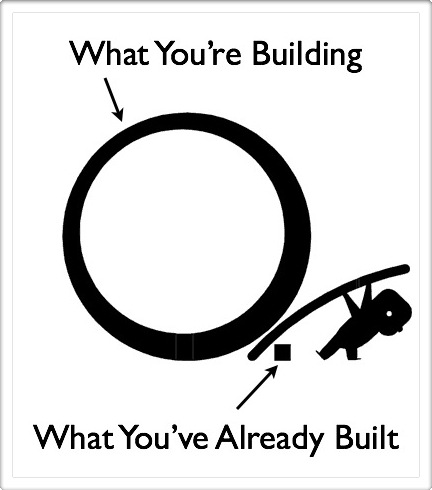Is your thought leadership strategy as solid as a rock? Let's get real—having a strategy…
Constantly Creating vs. Leveraging

In most businesses the goal is to develop a product, service or solution that can be leveraged. It’s not a very controversial topic – it’s just how companies operate. In the world of content it doesn’t always work that way.
I couldn’t image Steve Jobs ever telling his team, “Hey that MacBook thing is pretty cool, put I’m kind of bored with it and just want us to sell iPads this year.” I’d find it equally hard to believe that the folks at Proctor and Gamble would say the same thing about a line of toilet tissues that generates $3 Billion a year. However, authors and thought leaders do this all the time.
They create valuable assets in the form of workshops, articles, books, tools, models and the like, spending a tremendous amount of energy refining and honing them. They deliver them for a while and then create something else. This is what makes them special.
The ability to create content that can have a measurable change on individuals, teams and organizations. What also is unique about this behavior is that is more closely associated with a creative artist than someone that serves the business market. The question is why? Why would they continue to create new solutions before they maximized the return on their investment in assets that are incredibly valuable?
There are a few explanations:
1) Boredom – Delivering the same stuff (regardless of how incredible it is) gets boring. These are folks that need constant intellectual stimulation, that thrive on the challenge of solving a new problem, or an old problem in a unique way.
2) Lack of a Strategy – Content is created on a reactive basis. A client needs to solve problem X so the thought leader creates or revises some neat stuff to solve that problem and is off to the next client and the next client, and so on…
3) Fear of the Unknown – Creating great content requires a very different set of skills then marketing and selling it. The comfort zone is in the creative sphere and they don’t like, enjoy or understand how to leverage it effectively.
4) The Challenge – If they are not constantly challenged to come up with solutions they don’t want to take on the client or project. This is almost the opposite of how large consultancies work. They develop a deep expertise, perhaps by dominating a vertical, and go after the same type of clients over and over again. It might not be particularly challenging but it is profitable and provides the client with deep expertise (although it may be somewhat myopic).
So how do you “fix” this? The answer is you don’t – you work around it. Creative intellectuals need to create just like an artist or a film maker or a poet. And most of those folks don’t know how to (nor would they care to) learn how to maximize the assets they’ve developed over their careers. What they need to do is find a partner or a resource that thrives on leveraging content – that knows how to put the right deals together and let them be tasked with monetizing what the thought leader creates. This will generate the cash flow that will allow the thought leader to spend the time he/she enjoys creating content and will increase their exposure and brand in the process.
If you’re a thought leader I’d suggest you carve out a few hours to take an inventory of all the content you’ve created over your career. While it may be an activity that’s not particularly gratifying, it will give you a sense of what you actually have and will help you to prepare to have a conversation with someone that knows how to have those idle assets work for you while you’re free to create the next amazing solution.
Comments (11)
Comments are closed.





Hello Peter, interesting post. I’ve only thought a little bit about all the content I’ve created and how I can leverage it. Normally it’s just a matter of ‘how can I get this to the right people?,’ then getting it there, and finally moving on to the next thing. Little thought to maximizing those assets.
I recently spent an evening digging through old, old content (early songwriting demos). While I’m not playing seriously right now, I have some friends who are…and they’re looking for new material. I’ve polished one track up and sent it to them. Haven’t heard anything back from them yet, but I think this is a good example of letting someone else make use of my idle assets.
For many people (myself included), thinking about the things we create in terms of ‘assets’ rather than ‘stuff’ or ‘projects’ is a bit of a stretch and requires a shift in mindset…but this could be quite a valuable shift.
Hi Peter, very interesting thoughts. I am someone who has a foot firmly planted in both worlds. My take is a little different. Not every creative business has to operate like a large consultancy. In fact it is part of the distinction they offer. I am not sure that I would say they create out of boredom or a lack of strategy. Creating is what the creative person does, it’s almost impossible not to create new things. The challenge is not to “fix this” but to find ways to best utilize your gifts and talents. What seems a waste to others is not arduous or wasteful to the creative because it is how they function.
Peter;
Great post on a real problem area. We work predominately with financial services firms who for the most part have generated a lot of material. We have changed our approach to “repurpose” versus create. This allows us to leverage the best of our clients existing material and update as needed. Other benefits are speed to market and consistency of messaging to their target audiences.
Bruce
As a creative I am brought in to solve roadblocks, problems. However what I find is a hidden desire to box me in to solve them the way they have already tried.
So one way I stay creative is act as a “Heretic” as I discuss in my blog : http://nosmokeandmirrors.wordpress.com/2010/05/29/here%e2%80%99s-a-banana-for-your-baby-your-business/ Finding peace in not having company group think drives creative solutions and real market driven data.
Unfortunately I often have to “give banana’s to their babies”
Mark Allen Roberts
Great post, Peter! I repeat this to my clients every day. I agree with Karen that you want to have some of your time set on the creative side and constantly looking for new ideas but don’t forget to utilize what you already have. That goes for products and marketing.
Peter you described my world exactly.
I’m pulling together a team of people to help me with the “leveraging” bit.
My background as a constant creator started while in the ministry. I had to create a “new” sermon every week. Delivered it to essentially the same audience. And repeat the process.
Thanks for the DM that pointed me here.
Keep creating…and recreating,
Mike
Peter, thanks for the DM that linked to the post.
Interesting post and it does exactly what you suggest we do with our content, leverage it well.
It would be interesting to know what kind of social media is best to leverage content.
Hi Peter, thansk for the post, agree with you that creativity is a good differntiator. Now looking from outside there is a world of franchising and encouraging leveraging, actually if you read Michael’s Gerber work this is the essence. Here I have a market dominated by HR buyers who can choose flashy products, for the simple reason that those are coming from a franchise name. It is simple to cultivate same solutions that you constantly harvest, yes you get bored, but money flows.
I create new solutions and struggle to make this difference, however, trust me it is easier to repurpose.
Peter,
Thanks for direct messaging me on Twitter. I love this! You have really gotten me thinking. I keep creating and it mostly sits on a hard drive. I have begun the process of putting people around me who can leverage my content and ideas. I am idea rich and dollar poor. Not good enough. Thanks so much.
It’s a constant frustration of mine, working with writers and bloggers – so often they develop a good product, do a “launch” and then move on to create the next one. The result is the good product rarely reaches it’s potential.
From a business point of view, it’s crazy to put so much resource and effort into the creation and then not reap the reward.
Partnership between a creative type and a business type is a potential solution, but that can bring some big stresses and strains with it.
Hi Peter…great insights into what is going on…I believe the reasons are probably a combination of the different factors, although for some folks it may be one or the other. I am one of the creatives with a very well developed left brain that has a knack for seeing content as resuable, repurposable chunks or bits…and then uses software tools to leverage that reusability. I did this in the corporate world for almost 15 years and when I decided to do something else, dropped the approach like a hot potato. Now I’m looking at how to help coaches, speakers, healers, authors focus on what they do best and letting my team handle the repurposing stuff for them. The challenge there is that many of them, like myself when I’m in that mode, DO create on the fly in response to a need, a question, or problem. Plus many of them want to have fingertip control of the materials.
In the corporate world where I came from it was called “single sourcing” or some version of that and the savings were substantial. We were seeing 20-60% reductions in time-to-market and financial investments AFTER the content was analyzed and put into a technology system that could automate and streamline.
One thing I’ve found…whether working with corporations or ‘preneurs, this is something better done by an “outsider” trained to look at content from this way. I found that “insiders/owners” were typically too close to the material, too busy with other things or too frustrated with the process to see how this could be done without negatively affecting the products themselves.
Heck, I have enough challenges using this approach for myself and I know the benefits WELL…grin.
So the best thing from my perspective is for those who love to create to partner with those who love to repurpose and have a knack for it. This has been a match made in heaven when both parties respect the other’s skills and needs.
And, since I focus on people with a message of passionately powerful possibilities, it gets their message out into the world in a MUCH bigger way than 1 product can!
To partnerships and being a force for good in the world
MamaRed